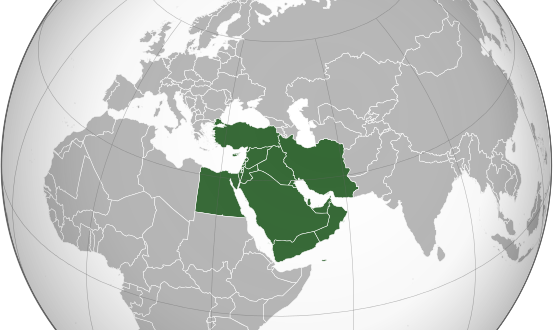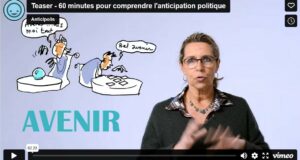After Iran and Turkey, a few weeks ago Saudi Arabia presented its “Visions for the future”, and our team considers it important to integrate the strategic developmental plans of the three major Middle East players in its anticipation work.
What seems of particular interest to our team is:
₋ on one hand (from a pessimistic angle) to anticipate the risks of collision between those plans;
₋ on the other hand (and in a more optimistic tone) to note the public nature of those agendas allowing the players to sit at a table and talk about it.
First, we will summarize the highlights of each of these Visions. Secondly, the risks of encroachment and collision are raised.
The similarity of these three agendas provides a beautiful example of the dangers presented by the multi-polarization of the world and its major regions. At the same time, there is no doubt that having more global-sized players, who have no other choice but to deal with each other, provides the conditions for a new type of governance.

Figure 1 – Map of the Middle East. Source: google map.
Today, while chaos is reigning in Syria and Iraq, three major protagonists emerge from the conflicted Middle East: Saudi Arabia, Iran and Turkey, three states involved in the Syrian conflict, with common interests regarding the Islamic State, but having different reactions with respect to the Syrian state; three states which have recently launched themselves in the conquest of another dimension, that of the future, of their future and of the future of this wide Middle East region. The most striking is, of course, the one named “Vision 2030”, a programme presented by Saudi Arabia in April, a model of its kind[1].
First of all, it is about their survival and about taking their states out of the economic, financial and social crisis. For Saudi Arabia, it is about coming out of the oil era and about its launching into the exploitation of new resources; for Turkey, it is about getting out of the European bee-eater, while keeping its pivotal role of mediator between Europe, Asia and Africa; for Iran, it is about conquering the world in order to recover its place among the Middle East power states.
Yet, it is also about creating room for the future of their political regimes, with all the faults they might have: absolute monarchy in Saudi Arabia, Mullahs’ regime in Iran, Erdogan’s leadership in Turkey. There is nothing better than projecting the immutability of state governance rules over 20 years.
Yet, whether it is Saudi Arabia, Turkey or Iran, it is primarily about ensuring a predominant role for each of them in the future organization of their region.
Saudi Arabia – Oil crisis; Yemen, Islamic State – Economic, financial and social stagnation, political archaism: on the horizon 2030, collapse or salvation
The oil era has just taken a sudden disturbing turn. The collapse of prices is not only the consequence of a decreased demand (to which the production decline has not been able to put an end), but a change in global paradigms. Indeed, during this global strategic retreat[2], the states seek to limit their dependence, including those related to energy: the United States became the first oil producer, “thanks” to the shale resources[3]; Europe turned to other sources (nuclear, coal, wind, solar and waterpower); new players have entered the market, including Iran.
Figure 2: Energy resources consumption – Source : peakoil.com
Burdened by structural debt, Saudi Arabia has to leave the petrodollar kingdom and diversify its energy resources. Some even predict the imminent end of this kingdom[4]: the country introduced late in 2015, for the third year in a row, a budget deficit of 20% of its GDP[5], and the 2016 forecasts do not look much better[6]. This state is burdened with debts, namely those of its princes. The reasons for this financial and economic downturn are, of course, the oil price collapse and also the astronomical costs of the war in Yemen[7]. The war is a military and economic catastrophe, weighing primarily on the future of the younger generation[8] as well as on the risks of social blunders, particularly among immigrant workers (second class citizens[9]).
« Saudi Arabia: the heart of the Arab and Islamic worlds, the investment powerhouse, and the hub connecting three continents… Africa, Asia and Europe »… This is the way the Council of Ministers of King Salman introduced Saudi Arabia’s Vision 2030. This is a development strategy which included the new face of Saudi Arabia in the twenty-first century world: modern, responsible (here we find all the issues of our time: ecology, economy, society, sustainability, solidarity…), multi-polar. What is missing, though, is the politico-democratic aspect (and here comes the notion of effectiveness and efficiency of the geostrategic political system of the Kingdom, as well as its agile role).
Finally, “Vision 2030” aims to give Saudi Arabia a “leadership role” in the Arab and Islamic world, providing it with economic and socially sustainable development. By forging a “nation”, it seeks to become a regional model, as we wrote in the last GEAB[10] “which has transformed the Gulf principalities into free zones and has extended, by pouring in petrodollars, its ideological influence throughout the poor Arab world, whose social fabrics have greatly suffered from this polarization between western modernity and Saudi archaism“. But previously, all this used to happen in the shadows…
Turkey’s central role[11]
Figure 3: Turkey’s central position. Source: Ali Velshi
Turkey, a leading power in the Middle East, directly affected both financially and socially by the geopolitical instability of its environment (Syrian intervention and Kurdish crisis, terrorist attacks and tourism decline, Russian sanctions against Ankara, mass numbers of refugees costing it $10 billion[12]) however has managed so far to maintain a moderate growth[13].
After negotiating with the EU the sealing of its borders against the flow of refugees and the visa liberalization for its citizens, Turkey is turning its back on Europe (marked by the ouster of its too pro-European Prime Minister, Ahmet Davutoglu)[14]. At the same time, it remains beneficiary of an important and traditional European financial windfall, which increased by six billion Euros with the refugee crisis in 2016/2017 (security has a price: Turkey is a direct step to the Schengen area in Europe and welcomes more than 2.5 million Syrian and Iraqi refugees[15], knowing that Lebanon welcomes only just more than one million and Jordan a little more than 600,000 – figures which obviously need to be connected to the national populations of those states).
Certainly, fulfilling the conditions for joining the EU in 2023 represents the first point of the “Vision 2023” programme (hence its name). However, besides the economic objectives which were recently recalled within nine points, the whole project is about the central role of Turkey in the region: economic and security cooperation, conflict resolution, global positioning, G10 integration and a major role in international organizations[16]… and in the Islamic world[17].
Iran: Persian Channel, Silk Road and even BRICS agenda – “back in the game”[18]

Figure 4: The new Silk Road, toward Iran. Source: the International Network
Iran’s international relations with the rest of the world are getting back to normal, except with the United States[19] and its allies in the Arab world (and Israel). These nations are questioning the religious differences and Iran’s hegemony, when in fact it is much more about keeping the economic appetite of this re-emerging country behind the wall created by international sanctions, a wall which has just fallen, as we all know[20]. While the oil embargo was lifted, opening the doors to exportations, Iran prefers higher prices to maximize the income of its production. Saudi Arabia, on the other hand, wants to keep prices as low as possible to compete with the price of the US shale[21].
That said, Iran’s return on the international stage after ten years of total blackout is definitely more of an opportunity for the country and for the world – the Europeans are not the last ones to ogle this new market, by the way[22], a promising market not only for oil resources, but also for rare mining treasures[23]. Also, it is interesting to note that, during the oil and trans-regional geopolitical crisis, Iran decided to take all possible advantage of its resources, without having to bear the same constraints as the American allies. Here we have a new opening market, free of western influence, detached from the petrodollar[24] (unlike Saudi Arabia[25]), which resolutely turns toward the emerging Asian world, to which it represents the first continental step[26].
Iran, with a population which is very young but growing in figures, frustrated by an unemployment rate of about 40%, with aging political leaders and systems, overnight has become an essential and central actor in the Middle East, imposing very serious developmental strategies.
During the last national conference on geopolitical developments in West Asia, Iran confirmed its strategy of turning resolutely toward Asia and of forming a grand coalition with the Asian powers[27], Russia, China, India and Pakistan, reconsidering at the same time a rapprochement with Turkey[28]. Iran is already one of the destinations of the Silk Road[29], a project which will fully root this country into the Asian continent. Iran plans to intensify its relations with India[30] and with Russia (through a channel-building project, connecting the Caspian Sea to the Persian Gulf[31]). Those are strategies relying on the multi-polar world, allowing the country to develop and avoid being trapped into an economy based on oil[32], but also to establish its leadership role and contribute, at the same time, to the emergence of conditions for regional stabilization and peace[33].
Unlike Saudi Arabia or Turkey, Iran can rely on its new agile and flexible economy, thanks to the fact that it does not systemically rely on the dollar world.
Modern, ambitious and multi-polar programmes
The “Visions” 2030 are presented as scale model economic, financial and technological projects, intended to ensure the development of the countries concerned. They are primarily conceived as bringing these countries into the G10, G20, at the global level, transforming them into major continental powers to take into account when speaking of geopolitical relations in the world.
Mega-projects: mega-bank, mega-channel, mega-extension of Mecca, mega financial hub… we are facing here powers which own the means and tools meeting the new paradigms of the twenty-first century’s modernity. The political and democratic aspects need some facelifts in order to allow people to join: Saudi Arabia is currently renewing its political class[34] by planning before 2020 the training of more than 500,000 civil servants[35] and by implementing a wide system of NGOs and volunteers who will support the Prince’s entire visionary project[36]. As for the democratic future of Turkey or Iran, the systemic changes will not be able to ensure the economic sustainability and the social stability without democratization. Moreover, the regional aspirations of these three players will imply that they also become political and social stability models. Unless there is a wish to build an empire, and thereby perpetuate the logic of war, people cannot guide the world without respecting the rights and freedoms of others. That’s the whole point of the multi-polar world, in fact.
If these programmes are part of the movement named the “great global strategic retreat”, as mentioned in our previous bulletins[37], it is clear that they must incorporate and get integrated into the multi-polar reality of the world, a multi-polarity which also applies to the Middle Eastern region. We therefore have three states claiming the same central position, the same pivotal role connecting three continents, Europe, Asia and Africa, counting on their preferred networks and partners. Saudi Arabia uses the Egyptian support, Iran uses Asia, and Turkey uses the European platform.
Mega-budget powers in terms of defence and security[38]: a future tinderbox
Placed at the heart of the Middle East tinderbox, directly involved in the conflict against the IS, Riyadh, Ankara and Tehran are armed to the teeth. The defence and arms budgets explode in Saudi Arabia, due to the Yemen war.
Erdogan in his fight against Daech is being forced to cooperate more with his army (the eighth army in the world and first in the Middle East) and thereby enables the military power to regain control of the Kurdish politics of Turkey. The war against the PKK in the Kurdish region has produced more than 500,000 internal refugees[39], increasing internal chaos, civil war and riots. As for Iran, while signing military procurement agreements with Russia[40], the parliament has, in the same spirit, given the green light for the country’s new defensive capacity building programme, by allocating 5% of the total budget to the financing plan of the Iranian defence complex[41].
We could legitimately worry about the military face of the three states, especially since their 2030 agendas clearly show that this entire military arsenal is intended to be produced by each of the three countries, in order to avoid any dependence on international contracts.
In 2030, arms dealers will have to worry, because most probably each state will be able to produce its own weapons and launch its own high-tech drone squadrons into the air, but especially international organizations should worry about such deployment of risky and uncontrollable death producing technologies.
Yet, we’re not even talking about nuclear proliferation. Of course, one thinks first of accusing Iran of developing its ballistic[42] missile program, but let’s face it, Saudi Arabia holds its own nuclear weapons[43] (reinforced by Donald Trump’s statements[44]), and Turkey, if it does not produce weapons itself, is suspected of holding some American bombs[45], NATO commands…
Hegemonic temptations of 2030/2036 agendas…
None of the three states is hiding its ambition to play the role of “leader” in the region, or even beyond that. This is how the Council of Ministers of King Salman introduced the Kingdom of Saudi Arabia’s Vision 2030: “Saudi Arabia at the heart of the Arab and Islamic worlds, an economic powerhouse, the hub that connects three continents, Africa, Asia and Europe”…
The same status is given to Erdogan’s Turkey, which occupies the best place for the East-West and North-South relations, meaning a market of 1.5 billion consumers in Europe, Eurasia, the Middle East and North Africa[46], willing to host in Istanbul in 2020 the Islamic Mega-bank[47]. There is also Rohani’s Iran, which claims to be part of the “Muslim” world[48] and projects itself into an Asian space.
As we have seen it above, Saudi Arabia uses the Egyptian support, while Iran uses Asian support, and Turkey is using Europe in its favour. Yet, all of them are addressing the entire Muslim or Islamic world, eyes pointed to the Middle East, this land which has continued to survive the upheavals of history, lining up one conflict after another, until this common enemy, and hopefully the last, Daech, an enemy bringing chaos in the Arab, Muslim, all-faith, all-sect, all-everything worlds.
Upon this community of interests, tempting Saudi Arabia, Iran and Turkey to become each the major player in the region, a new Middle East will emerge, open to multi-polar perspectives, to Asia, Russia, Europe, but also Africa, the latter firmly focused on its elder “brothers” creating more hopes around them than around the former colonizers and neo-colonizers[49].
Nevertheless, one more black hole should be avoided: the return of a US policy which has forsaken the land of the Middle East during the presidential campaign (a 6 month break, already) and has allowed Obama to finally implement his own geopolitical strategy, by defining himself the enemies or friends of the United States. In November, all this might change. Whether we are talking about Hillary Clinton, the well known anti-Iranian candidate, or Donald Trump[50], who continues to lambast Obama for abandoning the “friends” of the United States (Israel, Saudi Arabia), while at the same time he is threatening them to ask for explanations (mostly from the Muslim or Islamist “friends”), the risks of new upheaval partnerships, with new chaotic perspectives in this region, are higher and higher. Only then will long-term perspectives for the region really be determined.
Yet, we feel that the players are tired of waiting for Godot, and that their young populations aspire to other horizons, with the risk of falling into another dimension. The Middle East region should finally enjoy the “momentum” and consider now its own pacification tracks[51].
[1] The entire English text here Al Arabiya, 26/04/2016.
[4] Source: Le Saker Francophone, 06/03/2016.
[6] The debt grade was lowered to « AA- ». Source: La Presse.ca, 12/04/2016.
[7] Source: Opex, 29/12/2015. Leading weapon importer in the world, Saudi Arabia dedicates a quarter of its budget to the state’s defence and security, meaning 10.7% of its GDP. Source: La Banque Mondiale.
[8] Three quarters of the population is less than 30 years old and 60% less than 25 years old, the demographic curve going up. Source: United Nations, Demographic Components of Future Population Growth.
[9] Considering the violent riots of the 50,000 foreign employees of the Bin Laden Group who were asked to pack and leave the country, knowing they had not been paid for months. Source: Middle East Eye, 01/05/2016.
[10] Source: GEAB 104
[11] Title given to the GEAB 98, October 15, 2015
[12] Source: Al Monitor, 13/05/2016.
[15] Source: Commission européenne
[16] Source: Foreign Affairs, 2013
[18] Similar title, the Arabian Business, 11/03/2016.
[19] Source : 24heures.ch, 27/04/2016
[20] Read on the same topic: « Le bras de fer entre l’Arabie saoudite et l’Iran n’est pas vraiment sectaire ». Source: MiddleEastEye, 13/01/2016
[21] Source: MiddleEastEye, 13/01/2016
[22] Germany is the first recipient and should benefit from the Iranian exports of 2 billion Euros over 2015-2017. It is followed by France, Italy and the UK. Source: Le Monde, 25/01/2016.
[23] One of the leading 15 gold resources, but counting also on many more different minerals (around 68). Source: Rare Gold Nuggets
[24] Source: Indian Times
[26] Source: Teheran Times, 08/05/2016.
[27] Source: Iran Daily, 28/04/2016.
[30] Source: Times of India, 01/05/2016.
[31] Source: Russian Today, 11/04/2016.
[34] Mohammed Ibn Salman Al Saudi, Vice-Heir Prince, Minister of Defence, Second Vice-Prime Minister, President of the Economic Affairs Council, in charge of the oil and economic policies of the Kingdom, is only 31 years old. Source: Wikipedia. Another example would be the Oil Minister Ali al-Naimi, 81 years old and having ruled for 21 years. Source: SZ.de, 10/05/2016.
[35] Source: Vision 2030 § 3.1.5
[36] « Among our commitments: A more impactful non-profit sector », Vision 2030 § 3.2.3
[37] And here, before the « hard-landing » of Saudi Arabia or the integrant spirit of Iran. Source GEAB 101, 15/01/2016.
[38] Read also « Les dépenses mondiales d’armement s’envolent ». Source: L’Economiste, 22/02/2016.
[39] Source: Zaman France, 28/05/2016.
[42] Source: Tribune de Genève, 09/05/2016.
[45] Old information, true, but why would the situation have changed after all? Source: Sortir du nucléaire, 10/09/2010.
[46] Turkey, Vision 2023. Source: Foreign Affairs, 2013.
[48] Iran does not want a Shiite « croissant », it believes in the « Muslim moon ». Source: l’Orient le Jour, 22/04/2016.
[49] In the Middle East, as in North Africa, the 2030/2036 agendas are welcomed with interest, for instance in Algeria. Source: La Tribune, 27/04/2016; Kuwait: « Vision 2035 ». Source: Podcast Journal, 09/05/2016.
[50] Source: Al Arabiya, 18/04/2016.
[51] The Middle East can break free of Western hegemony and internal ills. Source: MiddleEastEye, 26/04/2016. Read also: THINK AGAIN: Egypt looks South, finally. Source: ISS Africa, 28/04/2016.


 LEAP2040 Toutes les informations et archives Europe2040
LEAP2040 Toutes les informations et archives Europe2040





